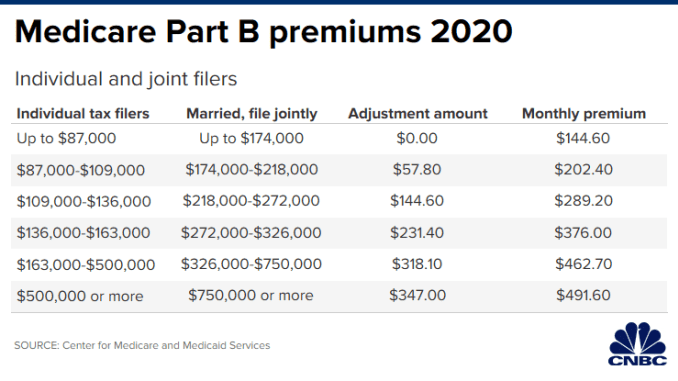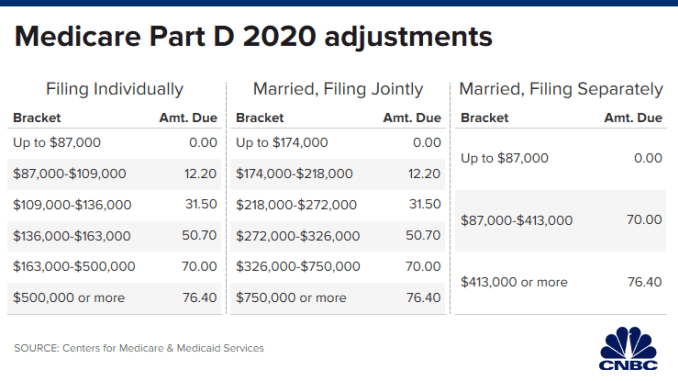Changes to Medicare in 2020
Here’s what you need to know about your 2020 Medicare costs
- Certain costs are adjusted yearly by the government and can affect premiums, deductibles and other cost-sharing aspects of Medicare.
- Even though each change doesn’t necessarily involve huge dollar amounts, they can add up and should be factored into your monthly health-care spending.
- Beneficiaries with limited income might qualify for Medicaid or other programs that cover Medicare expenses, while higher-income beneficiaries pay more for some parts of coverage.
The maze that is Medicare includes some higher costs for 2020 that beneficiaries might want to factor into their health-care budgets.
For the program’s 61 million beneficiaries — most of whom are 65 or older — certain costs are adjusted by the government from year to year and can affect premiums, deductibles and other cost-sharing aspects of Medicare. While each of the changes don’t necessarily involve huge dollar amounts, experts say it’s important to plan for how any increases will affect your household spending.
“For someone on a fixed income, all of those little changes really add up,” said Elizabeth Gavino, founder of Lewin & Gavino in New York and an independent broker and general agent for Medicare plans.

Basic Medicare consists of Part A (hospital coverage) and Part B (outpatient care). About a third of beneficiaries choose to get those benefits delivered through an Advantage Plan, which are offered by private insurers.
Those plans typically also include Part D prescription drug coverage, as well as extras such as dental or vision. They also limit what you pay out of pocket for Parts A and B services.
Other beneficiaries stick with basic Medicare and pair it with a standalone Part D prescription drug plan. About 30% of them also purchase a supplement plan — aka “Medigap” — which picks up some of the costs that come with basic Medicare, such as coinsurance or copays
And then, there are those in-between.
“We’ve got a subset of people who aren’t eligible for Medicaid or other types of assistance, but they fall into a category where every penny counts,” Gavino said.
Here are costs that have changed for 2020.
Parts A & B
Most Medicare beneficiaries pay no premium for Part A because they (or their spouse) have enough of a work history — at least 10 years — of paying into the system through payroll taxes to qualify for it premium-free.
If you don’t meet the minimum requirement, though, monthly premiums could be as much as $458 a month, depending on whether you’ve paid any taxes into the Medicare system at all. That maximum is up from $437 in 2019.
And, regardless of whether you pay a premium, there are cost-sharing aspects that go with Part A.
For those who don’t have additional coverage beyond basic Medicare, the amount you’d pay when admitted to the hospital will be $1,408 next year, up from $1,364 in 2019. That covers the first 60 days of Medicare-covered inpatient hospital care in a benefit period.
For the 61st through 90th days of a hospitalization, beneficiaries will pay $352 per day, up from $341 in 2019, and then $704 per day for 60 “lifetime reserve” days, up from $682 this year.
Meanwhile, for Part B, the standard premium in 2020 will be $144.60 monthly, up $9.10 from $135.50 in 2019.
Some recipients won’t pay the full standard premium due to a “hold harmless” provision that prevents their Part B premiums from rising more than their Social Security cost-of-living adjustment, or COLA.
Others, however, will pay more than the standard due to income-adjusted surcharges (see tables below).

Keep in mind that the government uses your tax return from two years earlier to determine whether you’ll pay those monthly adjustments. So for 2020, it would be your 2018 return. To request a reduction in that income-related amount due to a life-changing event such as retirement, the Social Security Administration has a form you can fill out.
The annual deductible for Part B will rise to $198, up from $185 in 2019. Once you meet that deductible, you typically pay 20% of covered services. Keep in mind that beneficiaries in Advantage Plans might pay a different amount through copays, and Medigap policies either fully or partially cover that coinsurance.

Also, while Advantage Plan premiums vary among plans — the average for 2020 is $23, down from about $27 this year — any monthly charge would be on top of your Part B premium. And, some of those options either have no monthly charge or will pay your Part B premium.
(If you don’t like your Advantage Plan, you can switch or drop it in the first three months of the year.)
Part D
How much you pay for drug coverage depends partly on the plan you choose, along with your income.
The average monthly premium for a standalone drug plan in 2020 will be $30, according to the Centers for Medicare and Medicaid Services, down from $32.50 in 2019. As with Part B premiums, higher earners pay extra (see chart below).
Those surcharges were adjusted slightly downward: for example, individuals with income above $500,000 (again, based on 2018 tax returns) will pay $76.40 extra each month, vs. $77.40 in 2019.

Be aware that those charges are not tacked on to your plan premium — they either come out of your Social Security check or you get a bill.
Also, while not everyone pays a deductible for Part D coverage — some plans don’t have one — the maximum it can be is $435 in 2020, up from $415 in 2019.
For people with high prescription costs, be aware that the amount that Part D enrollees pay out of pocket before qualifying for “catastrophic coverage” will jump to $6,350 in 2020 from $5,100 this year. In that phase of coverage, your share of prescription costs drops.
Remember, though, there are no out-of-pocket limits when it comes to Part D coverage. Sometimes, you can find medicines at a cheaper cost than through your plan, such as with a free drug-discount card or program, such as GoodRx or Blink Health, Gavino said.
However, she said, if you go this route instead of through your insurance, your plan won’t count the medicine’s cost and your copay toward your deductible or other calculations it uses to determine your share.
